Canada is one of the major locations for trading-related activities, whether it is done through seaborne or airborne. If you look at the statistics of Canada then you will get a sense of its importance in the modern world.
Canada covers ten provinces and three territories. It runs from the Atlantic to the pacific ocean covering territories and provinces. Canada borders cover several ocean fonts, the ports here are advanced with all the modern upgrades.
The size of the country also plays a significant role in trading-related business.
To better understand the subject, we will need to focus on the economy of Canada and how it has been impacting the world? All the ports in Canada have been developing with new technology and ways to ensure reliability while still maintaining the effectiveness of delivery.
When you look at the numbers, they all paint the ports of Canada to be increasing compared to what it was last decade. The Demand has also been seeing a rise as well.
Page Contents
The growth of Canadian container
To answer, What is Canada’s biggest port? We have to look at all the ports and learn all the key details about them. Only then we will get to see the larger picture.
Canada is one of the busiest container shipping markets in the world. The Canadian container volume went up to 7% last year. The container volume of the United State rose between 2 and 4, a 7% rise in Canadian containers has impacted the market in positive ways.
The speculations and the outlooks for the Canadian economy are bright, the reports speculate Canada promises to be one of the fastest-growing markets in the form of container trading. A larger growth has opened up the ports for new advanced developments.
So they will have an easier time handling the pressure. This means developing the terminal capacity, rail capacity, and other transportation to make the ports more effective than ever before.
The ports are also tackling plenty of issues, that includes climate change to make them more effective by leaving less carbon footprint as possible.
The role of Ports on The Economy Of Canada
The economy of Canada depends on the export and import system that is in place for the goods. Ports have been a major part of Canada’s economy for a long time.
Every aspect of the market is connected to the port. The list includes shippers, carriers, logistics companies, resource firms, natural resource firms, small-scale businesses, large-scale businesses, and more organizations that are connected to the ports every single day. The ongoing changes in port also impact the port’s capabilities.
Discalmers: This article is based upon statistics avaible on internet, so in this case it is not refering to 2021 ; but anyway it give a clear idea of the grow of the ports of Canada
The importance of Canadian ports in the modern world
The work that goes in the port sections is important to these businesses. If you take a look at the statistics from 2017, you will find that 17 percent of Canada’s exports were done through ports and marine shipping.
In other words, close to 90 billion exports and 110 billion imports were done through ports. Ports play international importance to the Canadian economy.
Canada now has 550 port facilities all dedicated to the trading system, seventeen of them serve strategic, regional, national, international, and continental purposes.
As the importance of ports has been growing each day, the federal government has invested over $715 million in them to make them more effective. Now the Canadian port authorities take more than 60% of the overall marine commercial authorities. In the year 2016, the Canadian port authorities grew 35% over the last 10 years. Many small and large-scale businesses use ports to expand their market and grow their business.
The Growth of ports also has an impact on the urban employment numbers. The ports allow hundreds of employees to distribute and handle the goods in the market.
Goods such as vehicles, smartphones, and plenty more consumer products arrive at the ports in a container. The sheer economic impact these ports have on the overall economy is huge. More people are getting employed within the ports, the new advanced modern technological revolution has enabled the ports to take on new ways of solution.
This has opened up new jobs in the market, each port of Canada has something different and unique to offer to the trade market. This Article Will focus on the ports and what makes them better for the trade? The economic impact and the advantage of technological development will also be an important subject in this article.
The strategic importance of the ports to Canadian trade
The results always lie in numbers, as they will reveal how effective a product can be. And the ports in Canada have the numbers that you will need to ensure the product is delivered in safe hands.
The Large quality of products always brings plenty of risk to the table. But the modern implementation of technology has made the port more capable of delivering the goods without any trouble or issue of any kind. Technological development has made the development of goods reliable.
The growth is important to any escort of transportation. The port has also been seeing a rise in its popularity, whether for goods and services or cruise lines. Here is the information regarding the development and its impact on the economy.
- They handle over 60% of the commercial cargo tonnage, which translates to 335 million tonnes of cargo. Compared to the number of cargo that was being handled in the year 2016, in 2017, they saw 25 million tonnes more than the previous year.
- The largest Canadian port authorities are Vancouver, Montreal, Prince Rupert, Halifax, Saint john. They handled over 6.33 million TEUs in 2027, which is an increase of 0.65 TEUs from 2015.
- The largest container port in Canada is the port of Vancouver, In 2017, this pot hanger over 3 million TEUs, which is an 11% increase compared to the previous year.
If you look at the numbers, you will see the ports are handling more goods than ever before. The increase of the services and demands have been rising in all communities.
So the port’s reliability has been increasing year after year. And it is showing no sign of stoppage any time soon. The operating revenues also increased from $580 million to $617 in the year 2015. This is how much attention the country is paying to its port sections. As they are now a large part of the Canadian economy and to the employment number.
So, What is Canada’s biggest port? In this article, you are going to find all the information about the biggest port in Canada and what makes it the highest compared to other ports in the region.
BIGGEST PORTS IN CANADA
#5 Port of Montreal
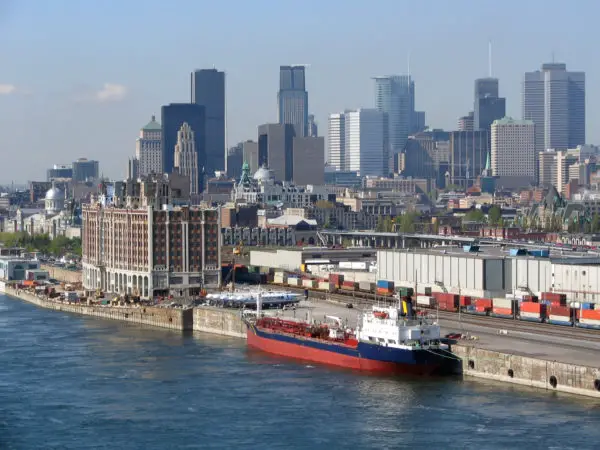
It is located on the Saint Lawrence River seaway. The port has a massive impact on the economy of Montreal and Quebec. The impact on the economy is based on its placement, the port is on the shortest direct trade route that connects North America and the Mediterranean Europe region.
General Information Port Of Montreal
- Opened in 1999.
- Owned by the Government of Canada
- The land area expands up to 6.35km
- 82 available berths
- The port employees up to 537 members
- Handles 2,738 vessels (2018)
- Annual cargo tonnage mounts to 40.500 million metric tons
- The port handles 1.74 trillion TEUs
Economical Impact Port Of Montreal
The port has created over 18,280 jobs and its impact is huge on the Canadian economy. As it brings over $1.5 billion in economic benefits to the economy of Canada the newer construction is making the port more powerful and productive. The port also created the logistics and transportation metropolitan cluster of Montreal or cargo Montreal in the area.
Modern Technology Port Of Montreal
Modern technology has made the port more effective than before. The new AI driven intelligence has helped raise the overall efficiency of the port, as they help the driver to pick up the drop from the containers easily.
More funding also helped with the reconstruction of the port, now they are building a new terminal, which will help the port to raise the annual capacity more than last year. The capacity of the port of Montreal is sitting at 1.45 million TEUs.
With the construction finished, the port of Montreal will be capable of handling 2.1 million TEUs without any pressure. The port also won plenty of awards in the work of communication, cruise sector and infrastructure, and its managerial process.
#4 Port of Prince Rupert
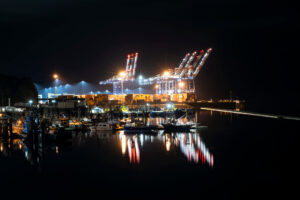
This port is seen as an alternative to the port of Vancouver, as the port of Prince Rupert is connected to the worldwide market. The Port handles exports such as wheat and barley through the food production terminal.
The Food production terminal is capable of handling seven million tonnes of grain on an annual basis. The storage capacity of port Prince Rupert is over 200,000 tonnes. It is connected to the north African, Americas, and middle east markets.
General Information Port of Prince Rupert
- It was opened in 1914.
- The port covers 667,731 hectares
- It has 5 available berths
- Annual cargo sits at 29.84 million metric revenue tons (2019)
- It handles annual container worth 1.21 million TEUs (2018)
- Port is capable of handling passenger traffic 12,435.
Economy Impact Port of Prince Rupert
The port of Prince Rupert handles well over $50 billion worth of imports and exports. Which generates more than $1.5 billion in annual economic activity.
This also helps the port to create thousands of jobs. Employment has increased, in some areas doubled compared to the previous year. The combined workforce here generates well over $400 million in wages for the families. Which is a 330% increase since 2009.
The Westview terminal of the port handles the exports of Lumber into European markets while the Ridley coal terminal handles the coal trading in Asian countries.
When it comes to exporting Canada’s natural resources, Port of Prince Rupert is the first one to get that call. The port is linked to the mines, forest, and field of Canada, this is the reason why the port is capable of handling the bulk of cargo coming from interior Alberta, Saskatchewan, and Manitoba.
It might not hold the answer to What is Canada’s biggest port? But the economical benefits contribute a lot to the Canadian economy.
#3 Port of Halifax
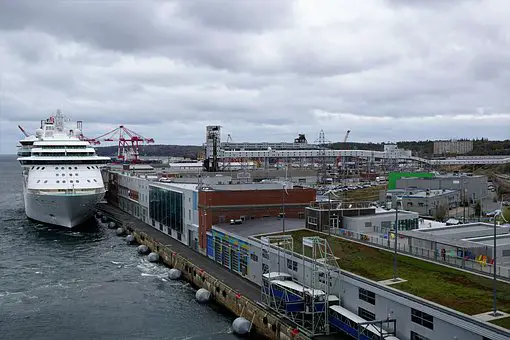
This port has a connection to over 150 economies worldwide. When it comes to moving products before the deadlines, the port of Halifax gets the job done without any issue. They Are known as professional enterprises as they plan to move over two mega vessels by the march of 2020. The port has been seeing an increased amount of traffic every single year. The Container traffic on the east coast of Canada, where the port of Halifax is loathed has increased.
General Information Port of Halifax
- The harbor covers 15,000 hectares
- The land area is 1,000 hectares
- 34 berths available in this port
- Annual cargo tonnage sits at 4,454,707
- The annual container number is 546,691 TEU (2019)
- The port handles passenger traffic up to 323,709.
Economic Impact Port of Halifax
Just like any other port, The port of Halifax has contributed a lot to the Canadian economy. As the port handles well over 1,500 vessels each year. This number of vessels welcomes up to 15,000 jobs for the people in the area. Halifax holds the title of capable of handling a large amount of cargo.
The port also handles cruise ships from all around the world, in the year 2019, the port of Halifax held over 179 cruise vessels carrying over 323,000 passengers. When you take a look at the statistics, cruise passengers bring around $172 million to the Halfiex economy annually.
The placement of the port is also very strategic, as it sits between the outgoing and inbound cargo traffic in North America. Being in the deepwater results in very few tides, which is the biggest advantage of the port of Halifax. The port is also known to carry a heavy amount of cargo, some of the cargo is oil, grain, gas, shipbuilding repair yard. The Port of Halifax is also opened to cruise liners.
#2 Port of Saint John
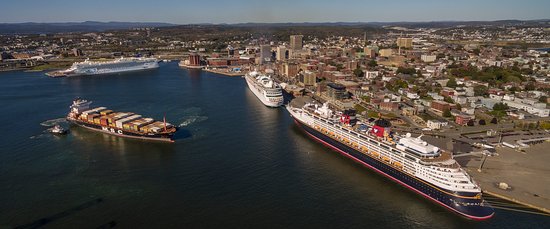
It lies in the east of the country and the port handles bulk, breakbulk, liquid cargo, dry cargo, and containers of all sorts. When it comes to numbers, the port of Saint John is capable of handling 28 million metric tonnes of cargo. It now connects up to 500 other ports worldwide. Which makes the port of saint john a major facilitator of commerce in Canada.
General information Port of Saint John
- It covers 120 hectares
- 17 berths available in this port
- The port covers 927 vessels
- Annual cargo tonnage is 30.5 million (2017)
- The annual container volume is at 59,102TEUs
- The port brings over 1,59,545 passengers.
Economical Impact Port of Saint John
The overall cargo tonnage at Saint John has increased by 8% by the end of 2018. Sometimes the cruise ship brings over a large number of visitors to the land.
The port has opened up plenty of jobs for the people in the area. The funding also enabled the port to expand and take bigger risks and cargo loading in near future.
The major highlight of the port of saint john is the connectivity that it has to others. It has a connection to the inland markets of Canada via rail and road transportations. There are terminals here that cater to crude oil, scrap metal recycling, and other goods and products.
#1 Port of Vancouver Biggest Port Of Canada
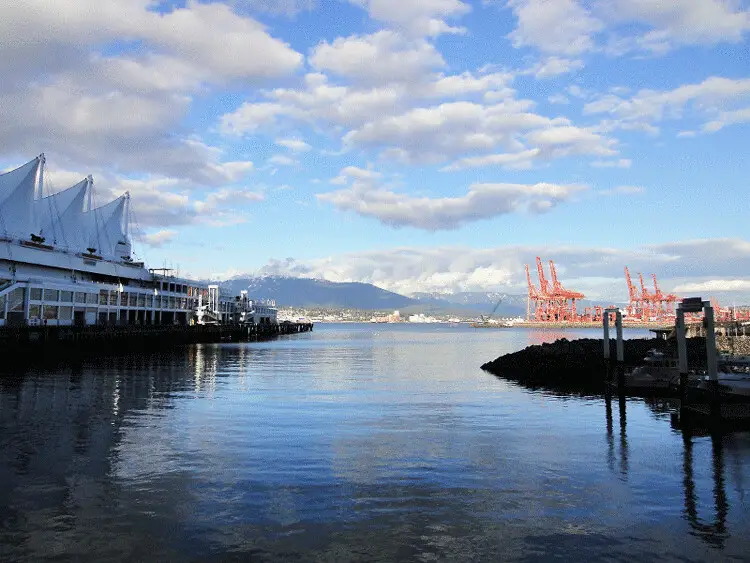
In the end, we have the port of Vancouver, which holds the title to the largest ports in the country. compared to other ports in the list, the port of Vancouver has more carrying capacity and holds more vessels for transportation.
If you are looking for an answer to What is Canada’s biggest port? Then here you have it, Port of Vancouver. Located on the southwest coast of British Columbia The port of Vancouver ranges from Roberts bank to the Burrard Inlet.
General Informations Port of Vancouver
- It was founded in 1964.
- The Coastline ranges to 247 kilometers, 4.6km on land, and 60km on water.
- It has 25 major marine terminals
- The port carries over 2,677 vessels.
- The Annual container volume sits at 1.8 TEU(2005)
- The amount of cargo it handles is over 100 million TEU
This port is considered the largest in the country and third-largest in tonnage capacity. The Port is serviced by a network of interstate highways and rail lines. The port of Vancouver is the main port that facilitates trade between nations and other world economies. There are various factors that make the port the largest port in entire Canada.
Economical Impact : Port of Vancouver
So, if you are looking for What is Canada’s biggest port? Then here is the reason why the Port of Vancouver is the largest port in all of Canada.
- When you look at the port from a geographical point of view, the port of Vancouver includes more than 16,000 hectares of water, 1,500 hectares of land, and hundreds of kilometers of the Canadian shoreline.
- The size of the port is so big, that it can contain the five largest Canadian ports without any trouble.
- The Port of Vancouver features 29 major terminals, as they handle a long range of cargo in the form of bulk, containers, breakbulk, liquid bulk, automobiles, and cruises.
- It handles over $240 billion in goods and employs over 100,000 people.
- Over the years, The port has created over $7 billion in wages.
- The port of Vancouver covers $11.9 billion of Canada’s GDP.
The first factor that puts the port Vancouver on the top, is the tonnage capacity. This port handles over 76 million metric tonnes of the country’s total cargo. This amount of cargo amounts to $43 billion in importing and exporting goods to other trading partners.
How many Terminal handling containers has the port of Vancouver ?
It has 25 terminal handling containers, bulk cargo, and breaks cargo ports. This houses over 30,000 people who deal with various work related to the port industry.
The work includes shipbuilding, maritime cargo, and repairs. Port offers an excellent platform to thousands of people for work and fulfill the basic needs of life. The maritime cargo sector is the largest sector to hold huge revenues and employment than the cruise industry sector.
It is not only the goods that have seen an increase every year in this port. The number of cruise lines is also seeing a rise compared to the number the year before. In the year 2019, the port handled over a million passengers from 288 cruise lines. This Was a 22% increase in passenger traffic from the previous year.
Operations : Port of Vancouver
The activity of the port of Vancouver is very complex and it also includes an organization that is beyond the authority of the port. Everything that gets handled in the port needs to be in order with the trade policy. The federal government has created trade policies for the activities that go down in the port.
The private terminal operations handle the loading and unloading of the cargo via port terminals, railways, and trucking companies handle goods by land, and lastly, the resource companies pay for the movement of the goods. These are the reasons why the port of Vancouver holds the perfect answer to What is Canada’s biggest port? It is better and effective in all aspects of port regulations.
Conclusion
The ports are now getting bigger as they now can execute plenty of tasks without getting bothered by the same problem.
The addition of modern technology has made the port more capable of handling more goods and delivered them without breaking the deadline.
Canada is also using freight fun of $1.54 billion to strengthen the infrastructure projects. This will attract the eyes of private investors from around the world.
That is not only it, the Canadian infrastructure bank is thinking of investing at least C$5 billion in trade and transportation.
The AI implementation, the GPS tracking, the electronic transmission has gotten rid of all the bottlenecks from the ports.
That’s it for this article i hope you find it usefull.
